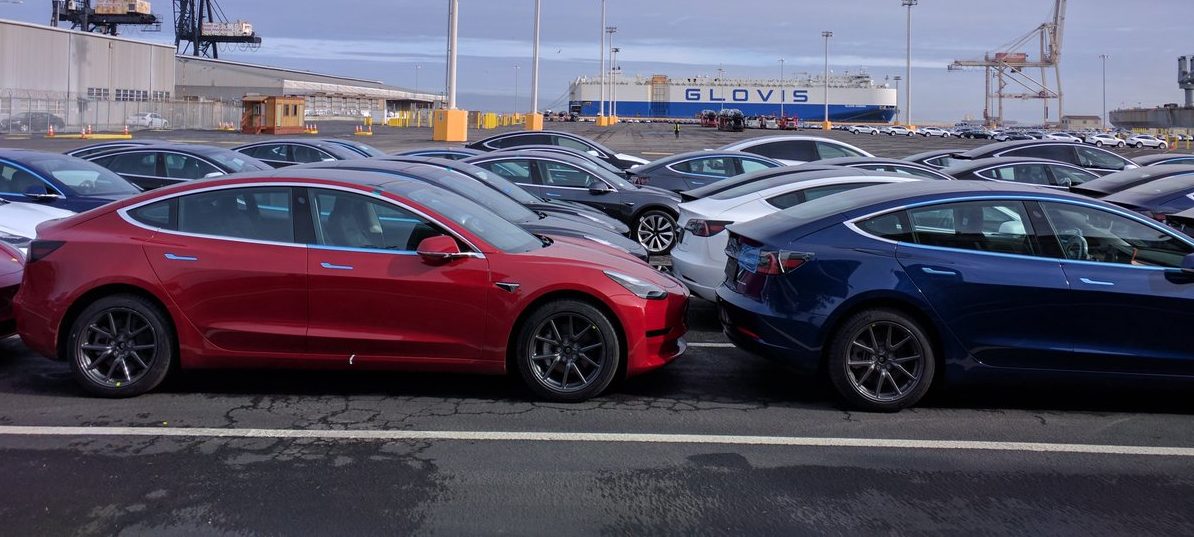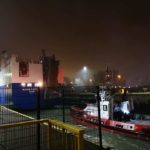

News
Tesla Model 3 invasion in Europe becomes imminent as cargo ship arrives in Belgium
After conquering the United States’s luxury car market in 2018, the Tesla Model 3 is now heading to foreign territories. In Elon Musk’s letter to employees last month, the CEO noted that the Model 3’s push in Europe and China this first quarter would be critical to the company’s profitability, particularly since deliveries in these territories would start with higher-priced variants like the Long Range AWD and the Performance variant. Amidst the anticipation of the Model 3’s worldwide distribution, reports have now emerged indicating that the first large batch of electric sedans has safely arrived at the port of Zeebrugge in Belgium.
Tesla has not shared details of the first Model 3 shipment that recently arrived in European shores. That said, reports from local media outlets back in December noted that Tesla would be shipping around 3,000 Model 3 to the Zeebrugge port every week. Reports also pointed out that the electric sedans would be shipped quickly, with the vehicles being loaded on RoRo (roll-on, roll-off) ships to facilitate quick loading and unloading. As another way to optimize the deliveries of Model 3 to the region, the transportation of the cars from the United States to Zeebrugge will reportedly take only about 15 days, considering that the cargo ships carrying the vehicles would be passing through the Panama Canal.
The first of these Model 3-filled cargo ships — the Glovis Captain — has been tracked religiously by the Tesla community from its departure in the United States to its arrival at the Belgian port. As noted by a number of dedicated Tesla enthusiasts who have been tracking the ship’s whereabouts, Glovis Captain has recently docked at Zeebrugge. With this, it would likely be just a matter of time before Tesla starts delivering the Model 3 to the first batch of reservation holders in the region. Following are pictures of the cargo ship in the Belgian port as shared by members of the Tesla community.
- (Photo: Ulric Dabe/Twitter)
- (Photo: Ulric Dabe/Twitter)
- (Photo: Ulric Dabe/Twitter)
- (Photo: Ulric Dabe/Twitter)
- (Photo: Kristof Lambrecht/Twitter)
The Glovis Captain arrives at the port of Zeebrugge. (Photos: Ulric Dabe and Kristof Lambrecht/Twitter)
With the arrival of the Model 3 in Europe, the disruption of the auto industry that the vehicle started in the United States could very well extend to the European region. In 2018, the Model 3 all but shook the US auto market, becoming such a force that it started closing in on mainstream passenger sedans like the Honda Accord and the Toyota Camry. By the end of 2018, the Model 3 was also hailed as a best-selling car in the US’ luxury auto market, selling more than 145,000 units during the year. It should be noted that the Model 3 accomplished these feats in the US despite Tesla’s production issues with the vehicle.
In a way, the true potential of the Model 3 might actually be seen in the vehicle’s performance in the European market, considering that passenger cars are an active, lucrative segment in the region. Compared to the United States, which largely favors SUVs and pickup trucks, Europe is far friendlier to sedans. In the company’s Q3 2018 Update Letter, Tesla noted that the mid-sized premium sedan market in Europe is “more than twice as big as the same segment in the US. In the recently released Q4 2018 letter, the company reiterated this point, stating that “the market opportunity for Model 3 in Europe and China exceeds North America based on the most recent sales of mid-sized premium sedans.”
Over the past months, the pieces have fallen in place for the Model 3’s European invasion. In January, it was confirmed that the electric sedan had achieved homologation approval, paving the way for a seamless rollout of the vehicles in the region. Test drive programs for the Model 3 have also begun in select European areas, giving reservation holders and potential customers a taste of what the electric sedan has to offer.

News
Tesla China delivery centers look packed as 2025 comes to a close
Needless to say, it appears that Tesla China seems intent on ending 2025 on a strong note.

Tesla’s delivery centers in China seem to be absolutely packed as the final days of 2025 wind down, with photos on social media showing delivery locations being filled wall-to-wall with vehicles waiting for their new owners.
Needless to say, it appears that Tesla China seems intent on ending 2025 on a strong note.
Full delivery center hints at year-end demand surge
A recent image from a Chinese delivery center posted by industry watcher @Tslachan on X revealed rows upon rows of freshly prepared Model Y and Model 3 units, some of which were adorned with red bows and teddy bears. Some customers also seem to be looking over their vehicles with Tesla delivery staff.
The images hint at a strong year-end push to clear inventory and deliver as many vehicles as possible. Interestingly enough, several Model Y L vehicles could be seen in the photos, hinting at the demand for the extended wheelbase-six seat variant of the best-selling all-electric crossover.
Strong demand in China
Consumer demand for the Model Y and Model 3 in China seems to be quite notable. This could be inferred from the estimated delivery dates for the Model 3 and Model Y, which have been extended to February 2026 for several variants. Apart from this, the Model Y and Model 3 also continue to rank well in China’s premium EV segment.
From January to November alone, the Model Y took China’s number one spot in the RMB 200,000-RMB 300,000 segment for electric vehicles, selling 359,463 units. The Model 3 sedan took third place, selling 172,392. This is quite impressive considering that both the Model Y and Model 3 are still priced at a premium compared to some of their rivals, such as the Xiaomi SU7 and YU7.
With delivery centers in December being quite busy, it does seem like Tesla China will end the year on a strong note once more.
News
Tesla Giga Berlin draws “red line” over IG Metall union’s 35-hour week demands
Factory manager André Thierig has drawn a “red line” against reducing Giga Berlin’s workweek to 35 hours, while highlighting that Tesla has actually increased its workers’ salaries more substantially than other carmakers in the country.

Tesla Giga Berlin has found itself in a new labor dispute in Germany, where union IG Metall is pushing for adoption of a collective agreement to boost wages and implement changes, such as a 35-hour workweek.
In a comment, Giga Berlin manager André Thierig drew a “red line” against reducing Giga Berlin’s workweek to 35 hours, while highlighting that Tesla has actually increased its workers’ salaries more substantially than other carmakers in the country.
Tesla factory manager’s “red line”
Tesla Germany is expected to hold a works council election in 2026, which André Thierig considers very important. As per the Giga Berlin plant manager, Giga Berlin’s plant expansion plans might be put on hold if the election favors the union. He also spoke against some of the changes that IG Metall is seeking to implement in the factory, like a 35-hour week, as noted in an rbb24 report.
“The discussion about a 35-hour week is a red line for me. We will not cross it,” Theirig said.
“(The election) will determine whether we can continue our successful path in the future in an independent, flexible, and unbureaucratic manner. Personally, I cannot imagine that the decision-makers in the USA will continue to push ahead with the factory expansion if the election results favor IG Metall.”
Giga Berlin’s wage increase
IG Metall district manager Jan Otto told the German news agency DPA that without a collective agreement, Tesla’s wages remain significantly below levels at other German car factories. He noted the company excuses this by referencing its lowest pay grade, but added: “The two lowest pay grades are not even used in car factories.”
In response, Tesla noted that it has raised the wages of Gigafactory Berlin’s workers more than their German competitors. Thierig noted that with a collective agreement, Giga Berlin’s workers would have seen a 2% wage increase this year. But thanks to Tesla not being unionized, Gigafactory Berlin workers were able to receive a 4% increase, as noted in a CarUp report.
“There was a wage increase of 2% this year in the current collective agreement. Because we are in a different economic situation than the industry as a whole, we were able to double the wages – by 4%. Since production started, this corresponds to a wage increase of more than 25% in less than four years,” Thierig stated.
News
Tesla is seeing a lot of momentum from young Koreans in their 20s-30s: report
From January to November, young buyers purchased over 21,000 Teslas, putting it far ahead of fellow imported rivals like BMW and Mercedes-Benz.

Tesla has captured the hearts of South Korea’s 20s-30s demographic, emerging as the group’s top-selling imported car brand in 2025. From January to November, young buyers purchased over 21,000 Teslas, putting it far ahead of fellow imported rivals like BMW and Mercedes-Benz.
Industry experts cited by The Economist attributed this “Tesla frenzy” to fandom culture, where buyers prioritize the brand over traditional car attributes, similar to snapping up the latest iPhone.
Model Y dominates among young buyers
Data from the Korea Imported Automobile Association showed that Tesla sold 21,757 vehicles to the 20s-30s demographic through November, compared to BMW’s 13,666 and Mercedes-Benz’s 6,983. The Model Y led the list overwhelmingly, with variants like the standard and Long Range models topping purchases for both young men and women.
Young men bought around 16,000 Teslas, mostly Model Y (over 15,000 units), followed by Model 3. Young women followed a similar pattern, favoring Model Y (3,888 units) and Model 3 (1,083 units). The Cybertruck saw minimal sales in this group.
The Model Y’s appeal lies in its family-friendly SUV design, 400-500 km range, quick acceleration, and spacious cargo, which is ideal for commuting and leisure. The Model 3, on the other hand, serves as an accessible entry point with lower pricing, which is valuable considering the country’s EV subsidies.
The Tesla boom
Experts described Tesla’s popularity as “fandom culture,” where young buyers embrace the brand despite criticisms from skeptics. Professor Lee Ho-geun called Tesla a “typical early adopter brand,” comparing purchases to iPhones.
Professor Kim Pil-soo noted that young people view Tesla more as a gadget than a car, and they are likely drawn by marketing, subsidies, and perceived value. They also tend to overlook news of numerous recalls, which are mostly over-the-air software updates, and controversies tied to the company.
Tesla’s position as Korea’s top import for 2025 seems secured. As noted by the publication, Tesla’s December sales figures have not been reported yet, but market analysts have suggested that Tesla has all but secured the top spot among the country’s imported cars this year.













